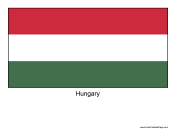
Please note! The volunteers in our Rotary District are always working to add new countries, and monitoring conditions in existing countries. Countries on this list may or may not be available and are subject to change without notice.
Hungary (Hungarian: Magyarország, in English officially the Republic of Hungary (Magyar Köztársaság, literally Magyar (Hungarian) Republic), is a landlocked country in the Carpathian Basin of Central Europe, bordered by Austria, Slovakia, Ukraine, Romania, Serbia, Croatia, and Slovenia. Its capital is Budapest. Hungary is a member of OECD, NATO, EU, V4 and is a Schengen state. The official language is Hungarian, which is part of the Finno-Ugric family, thus one of the four official languages of the European Union that are not of Indo-European origin.
Following a Celtic (after c. 450 BC) and a Roman (9 AD - c. 430) period, the foundation of Hungary was laid in the late 9th century by the Hungarian ruler Árpád, whose great-grandson Stephen I of Hungary was crowned with a crown sent from Rome by the pope in 1000. After being recognized as a kingdom, Hungary remained a monarchy for 946 years, and at various points was regarded as one of the cultural centers of the Western world (Stephen I, Béla IV, Louis I, Matthias I, Lajos Kossuth, István Széchenyi). A significant power until the end of World War I, Hungary lost over 70% of its territory, along with 3.3 million people of Hungarian ethnicity, under the Treaty of Trianon, the terms of which have been considered humiliating by Hungarians. The kingdom was succeeded by a Communist era (1947 - 1989) during which Hungary gained widespread international attention regarding the Revolution of 1956 and the seminal move of opening its border with Austria in 1989, thus accelerating the collapse of the Eastern Bloc. The present form of government is a parliamentary republic (since 1989). Today, Hungary is a high-income economy, and a regional leader regarding certain markers. Its current goal is to become a developed country by IMF standards.
In the past decade, Hungary was listed as one of the 15 most popular tourist destinations in the world. The country is home to the largest thermal water cave system and the second largest thermal lake in the world (Lake Hévíz), the largest lake in Central Europe (Lake Balaton), and the largest natural grassland in Europe (Hortobágy).
This text provided by Wikipedia under the terms of the Creative Commons Attribution-ShareAlike License